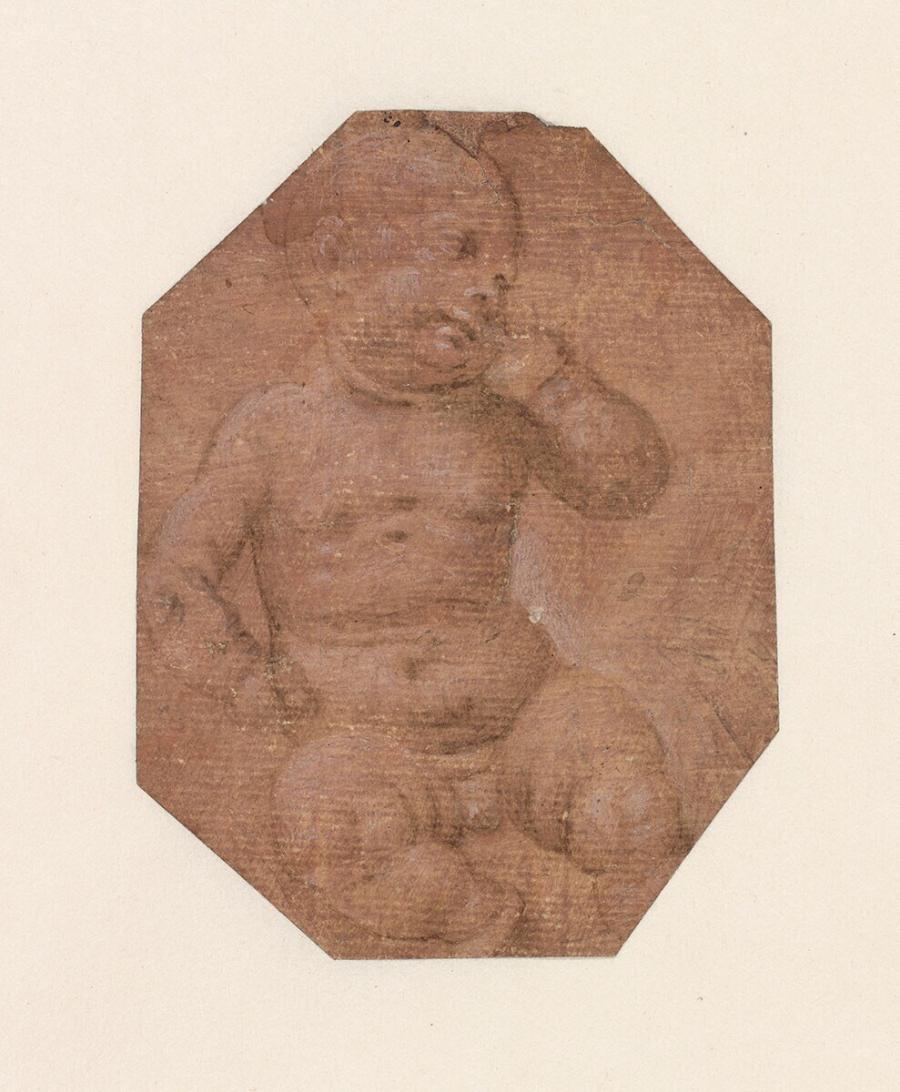Specifications
| Title | Nude Boy, Sitting on the Ground |
|---|---|
| Material and technique | Pen and brown ink, heightened with white with brush, on grey prepared paper, indented for transfer |
| Object type |
Drawing
> Two-dimensional object
> Art object
|
| Location | This object is in storage |
| Dimensions |
Height 133 mm Width 101 mm |
|---|---|
| Artists |
Workshop of:
Andrea del Verrocchio
Previously attributed: Lorenzo di Credi Previously attributed: Fra Bartolommeo (Bartolomeo-Domenico di Paolo del Fattorino, Baccio della Porta) |
| Accession number | I 457 (PK) |
| Credits | Loan Stichting Museum Boijmans Van Beuningen (former Koenigs collection), 1940 |
| Department | Drawings & Prints |
| Acquisition date | 1940 |
| Creation date | in circa 1485-1500 |
| Watermark | ? (heavily prepared paper, vH, 2P) |
| Inscriptions | '111' (removed backing sheet, above left, pencil), '30' (idem, above left, red chalk), '344' (idem, below left, pencil), 'Il frate Fra Bartolommeo' (idem, below right, pencil), '1' (idem, below left, pencil) |
| Collector | Collector / Franz Koenigs |
| Mark | E. Desperet (L.721), W. Bateson (L.2604a), F.W. Koenigs (L.1023a), all on removed backing sheet |
| Provenance | Etienne (called Auguste) Desperet (1804-1865, L.721), Paris; his sale, Paris (Clément) 07-13.06.1865, possibly in lot 28 (Fra Bartolommeo, FF 23, probably with lot 27); - ; Dr. Benno Geiger (1882-1965), Vienna/Venice; his sale London (Sotheby's) 07-10.12.1920, lot 82, ill. (Lorenzo di Credi, BP 16 to Bateson); William Bateson (1861-1926, L.2604a), London; his sale, London (Sotheby) 23.04.1929, lot 34 (Lorenzo di Credi, BP 20 to Lambert); Franz W. Koenigs (1881-1941, L.1023a), Haarlem, acquired in 1929 (Fra Bartolommeo); D.G. van Beuningen (1877-1955), Rotterdam, acquired with the Koenigs Collection in 1940 and donated to Stichting Museum Boijmans Van Beuningen |
| Research |
Show research Italian Drawings 1400-1600 |
| Literature | Planiscig/Voss 1920, no. 3, ill. (Lorenzo di Credi); Berenson 1938, no. 2762c ('Tommaso'); Berenson 1961, nr. 2764 A-I |
| Material | |
| Object | |
| Technique |
Prepare
> Prepared
> Shaping techniques
> General technique
> Technique
> Material and technique
Prepare
> Prepared
> Shaping techniques
> General technique
> Technique
> Material and technique
Trace
> Traced
> Drawing technique
> Technique
> Material and technique
Trace
> Traced
> Drawing technique
> Technique
> Material and technique
Highlight
> Painting technique
> Technique
> Material and technique
|
| Geographical origin | Italy > Southern Europe > Europe |
| Place of manufacture | Florence > Tuscany > Italy > Southern Europe > Europe |
Do you have corrections or additional information about this work? Please, send us a message























